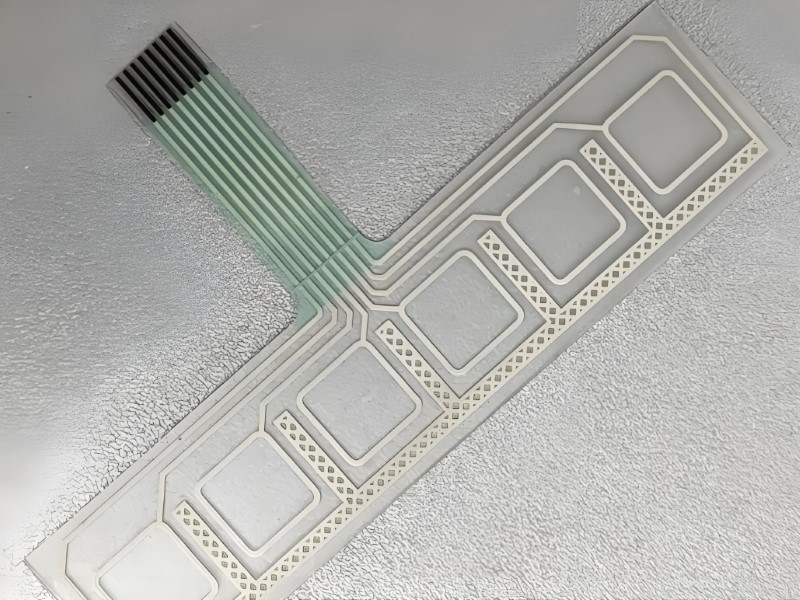Introduction
Touch-sensitive membrane switches represent a breakthrough in user interface technology, blending the versatility of traditional membrane switches with advanced touch sensitivity. These switches have redefined how users interact with devices, offering a seamless, durable, and intuitive experience. In this guide, we’ll explore the technology behind touch-sensitive membrane switches, their applications, unique selling points, design benefits, and overall value for industries.

Product Highlights: What Are Touch-Sensitive Membrane Switches?
Touch-sensitive membrane switches operate by detecting the slightest touch from users, eliminating the need for physical buttons. Their slim design consists of multiple functional layers, including a touch-sensitive circuit layer and a graphic overlay, which work together to sense touch input accurately and efficiently. Key features include:
- Sleek, Modern Interface: A flat, buttonless surface that enhances device aesthetics.
- Enhanced User Experience: Effortless touch activation with accurate responsiveness.
- Durability: High resistance to dust, moisture, and impact, ideal for rugged applications.
Solving Key User Pain Points
Touch-sensitive membrane switches address common pain points associated with traditional switches:
- Improved User Interaction: The lack of physical buttons allows users to activate functions with a simple touch, improving accessibility and ease of use.
- Space Optimization: With a thinner profile than traditional buttons, they fit seamlessly into compact devices, allowing for more streamlined designs.
- Reliability in Harsh Conditions: Dust, water, and impact resistance make touch-sensitive membrane switches ideal for environments that challenge traditional mechanical switches.
- Reduced Maintenance: Fewer moving parts mean these switches have a longer lifespan, reducing maintenance and replacement needs.
Application Areas of Touch-Sensitive Membrane Switches
Touch-sensitive membrane switches are making a significant impact across industries, including:
- Medical Devices: Used in patient monitoring systems, diagnostic equipment, and infusion pumps, where smooth operation, hygiene, and ease of use are essential.
- Consumer Electronics: Common in remote controls, home appliances, and wearable devices, providing sleek, responsive controls that enhance the user experience.
- Industrial Equipment: Ideal for machinery interfaces in rugged environments, as they withstand wear, tear, and exposure to harsh conditions.
- Automotive Industry: Used in infotainment systems and dashboard controls, offering a modern look and feel that aligns with premium vehicle aesthetics.
Advantages of Touch-Sensitive Membrane Switches
These switches offer several advantages over traditional membrane or mechanical switches:
- Touch Accuracy: With a highly responsive surface, touch-sensitive membrane switches provide a smooth, intuitive user experience.
- Durability: They are resistant to moisture, dust, and temperature fluctuations, making them suitable for challenging applications.
- Ease of Cleaning: A flat, buttonless surface is easier to clean, which is especially beneficial in industries with strict hygiene standards.
- Energy Efficiency: Low energy consumption allows them to be integrated into battery-operated devices without significant power drain.
The Technology Behind Touch-Sensitive Membrane Switches
The technology of touch-sensitive membrane switches combines several advanced elements:
- Conductive Circuitry: The touch-sensitive layer often uses conductive ink printed on flexible materials, enabling the detection of touch without traditional buttons.
- Capacitive or Resistive Technology: Capacitive sensors are commonly used for precise touch detection, responding to changes in capacitance when a finger touches the surface.
- Printed Circuit Layers: These switches contain multiple layers with precise circuit printing to enable touch sensing across the entire interface.
- Graphic Overlays: The top layer includes the visual interface, designed to be aesthetically pleasing while ensuring durability and clarity of printed symbols or instructions.
Design Selling Points: What Sets Touch-Sensitive Membrane Switches Apart?
The design elements of touch-sensitive membrane switches provide unique advantages:
- Customizability: The graphic overlay can be fully customized with colors, symbols, and logos, providing both functionality and brand alignment.
- Integration with Backlighting: LED or EL backlighting can be incorporated to improve visibility in low-light conditions, enhancing usability in various environments.
- Ergonomic Design: With no physical buttons to press, these switches are easier to use and reduce strain, especially in repetitive applications.
- Enhanced Aesthetics: The buttonless, smooth surface aligns with modern device designs, providing a sleek, futuristic look that appeals to today’s consumers.
Value Proposition of Touch-Sensitive Membrane Switches
Investing in touch-sensitive membrane switches offers significant value across various domains:
- Product Longevity: Their durable construction reduces the likelihood of failure, extending product lifespan and lowering long-term costs for manufacturers and end-users.
- Enhanced Brand Image: The sleek, modern design conveys a sense of quality and innovation, enhancing brand perception and consumer trust.
- Flexible Applications: Due to their robust performance and design flexibility, these switches can be adapted to new applications as device needs evolve, making them a versatile choice for future-forward companies.
- User Satisfaction: With responsive touch activation and a modern interface, these switches create a positive user experience, increasing satisfaction and brand loyalty.
Conclusion
Touch-sensitive membrane switches represent a powerful combination of design, functionality, and durability. With their advanced touch technology, versatile applications, and customizable design, they have become an ideal choice for industries ranging from medical to consumer electronics and beyond. As user expectations continue to evolve toward more intuitive, responsive interfaces, touch-sensitive membrane switches will remain essential components for innovative and user-centric devices. Their unique advantages make them not only a practical solution but also a valuable addition to any modern device interface.
